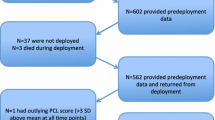Abstract
Solider life exists on a continuum of readiness for deployment. Re-entry and reintegration—the return home and reunion with family and community—key the success of the deployment cycle. In current and projected future operations, the Army and society will both bear the burden of this re-entry and re-integration. Programs and procedures in place work towards improving communication, mitigating distress and resolving crises during reentry and reintegration. Key elements include: inclusion of families and communities early into the planning for reentry and reintegration; normalization (non-medicalization of distress); easy access to behavioral health professionals; and education of families on resources and benefits. Through broad collaboration, maximal benefit to the Soldier, family members and society be realized.
Similar content being viewed by others
References
Jos MP, White W, Adler AB, Castro CA, Algra G, Bramsen I, Dirkswager AJE, Ploeg HM, de Vries M, Zillman A (2002). Studies in military peacekeepers (pp. 31–48). In Y. Danieli (Ed.), Sharing the front line and the back hills, Baywood Publishing: Amityville, New York.
Schumm WR, Bell DB, Knott B: Characteristics of families of soldiers who return prematurely from overseas deployments: An assessment from Operation Restore Hope (Somalia). Psychological Reports 86(3 pt 2): 1267–1272.
Hoge CW, Castro CA, Messer SC et al: Combat duty in Iraq and Afghanistan, mental health problems, and barriers to care. New England Journal of Medicine 351(10):13–22.
Kirkland F: Post Combat Re-Entry, in War Psychiatry. Textbook of Military Medicine. Office of the Surgeon General, 1995.
I (US) Corps OPLAN 04-10 (Return to Readiness) (Unclassified). Fort Lewis, WA. April 2004.
Memorandum of Understanding between Washington State Military Department, Washington State Department of Veterans Affairs, Washington State Employment Security Department, U.S. Department of Veterans Affairs, Benefits Administration, U.S. Department of Veterans Affairs, Health Administration, U.S. Department of Labor, Association of Washington Business, Governor's Veterans Affairs Advisory Committee, November 2004.
Getting Back Together (Homecoming/Reunion), U.S. Army training video, TVT20-1048, 1994.
Author information
Authors and Affiliations
Corresponding author
Rights and permissions
About this article
Cite this article
Doyle, M.E., Peterson, K.A. Re-Entry and Reintegration: Returning Home after Combat. Psychiatr Q 76, 361–370 (2005). https://doi.org/10.1007/s11126-005-4972-z
Issue Date:
DOI: https://doi.org/10.1007/s11126-005-4972-z




